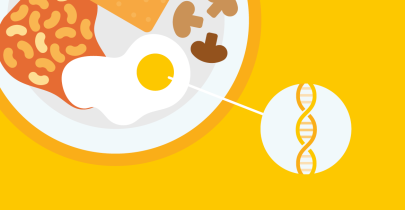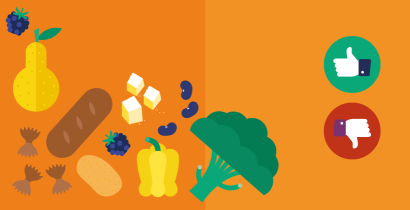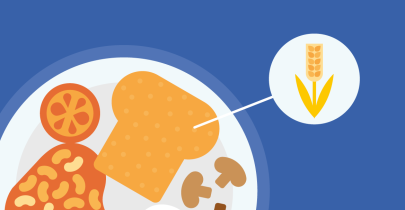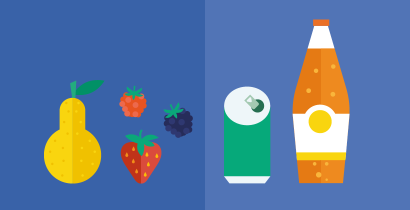Sugars: Addressing Common Questions
Last Updated : 27 November 2023Sugars are common components of our diets. They are found in a wide range of foods and drinks, both naturally and in added form, including in fruit and fruit juices, milk and dairy products, honey, jams and marmalades, soft drinks, ready-meals, vegetable products (e.g. tomato ketchup), desserts, and other sweet treats. Sugars provide a sweet, pleasant taste to our foods and are the most basic source of energy for our bodies. With the increase in added and free sugars consumption over the last decades, alongside the rise of obesity and related illnesses, the role of sugar in our health has been questioned. This article provides answers to some widespread questions on the link between sugars and health, drawing on the latest scientific evidence.
What exactly is sugar?
Sugars are the building blocks of all carbohydrates and can be classified into monosaccharides, disaccharides, oligosaccharides and poly-saccharides:
- Monosaccharides are one-unit-only sugars like glucose, fructose and galactose.
- Disaccharides consist of a combination of two individual one-unit-only sugars to form table sugar (sucrose) or milk sugar (lactose).
- Oligosaccharides are medium chains of single-unit sugars and include mannose and fibres such as short-chain inulin.
- Poly-saccharides are long single-unit sugar chains and include starches like those found in potatoes, onions and carrots.
Sucrose is the sugar combination which is commonly referred to as ‘table sugar’. Other uses of the term ‘sugar’ may more generally refer to monosaccharides and disaccharides. You can find an overview of the different types of sugars in our article on ‘The functions of carbohydrates in our body’.
Are naturally occurring sugars healthier than added sugars?
No, sugars – whether they occur naturally or are added to foods – are chemically the same and have the same effect on our bodies.
Sugars are sometimes categorised as ’natural‘, ’total‘, ’free‘, or ’added’1, which may lead us to think that sugars themselves could be ’healthier‘ or not, which is technically incorrect. However, foods in which sugars naturally occur – be it grains, pulses, fruit or vegetables – usually contain fibres and other nutrients alongside sugars, and as such are better for our health than foods containing predominantly added sugars (all monosaccharides and disaccharides added to foods by the manufacturers, cooks, or during cooking at home) or free sugars (all added sugars plus sugars naturally present in honey, syrups, and fruit juices). Indeed, a high intake of added and free sugars is a risk factor for many preventable diseases, whereas naturally occurring sugars from a diet rich in wholegrains, fruit and vegetables are of no concern.2,3
Is sugar in fruit bad?
No, sugars in fruit are not bad. Fruit contains sugars in addition to nutrients such as vitamins, minerals and fibre. It means you receive additional health benefits through consuming fruit rather than fruit sugars by themselves whilst the sugar contributes to your body’s energy metabolism.
The main sugar occurring in fruit is fructose and there was some concern a few years ago about its health effects on our bodies (see also our article on ‘What is fructose and is it bad for you?‘).
Previous scientific research showed little evidence that fructose itself causes health problems and not in the amounts eaten within a general European diet, particularly as part of whole fruits.4-6 Currently, some research suggests that a high fructose intake may increase the risk of some chronic diseases like gout, but it’s still unclear if these findings can apply to the European population.7 Regardless, the European Food Safety Authority (EFSA) points out that the overall reduction of added and free sugars in the diet can help limit the intake of fructose, especially that from food sources other than whole fruit.
What is the healthiest alternative to sugar?
No type of sugar is healthier than another, as the way sugar is used by the body is similar and always amounts to approximately four calories of energy per gram (4 kcal/g). For many of us, the ‘healthiest alternative’ is to reduce sugar consumption in the diet. A reduction of sugars in the diet can be achieved step-by-step by reducing the amount of sugar used in home-cooked or home-baked recipes as well as store-bought products, whilst still achieving a satisfactory sweetness (and fullness) in the recipe.
Can sugars cause overweight and obesity?
Yes, sugars, like other calorie-containing nutrients, can contribute to overweight and obesity when consumed in excessive amounts.7-9 Foods high in sugars are sweet, which makes them very attractive to the brain and may cause us to eat past moderate amounts. Hence, managing sweetness in our diet may require special vigilance. Paying attention to portion size and energy content of our foods – especially if they’re also high in other caloric nutrients like fat – and soft drinks, will ensure that daily calories do not exceed our energy requirements.
Does sugar cause diabetes?
Possibly. Evidence from research shows that a high consumption of soft drinks can increase the risk of type 2 diabetes.7,8,10 Furthermore, a probable link between the intake of fruit juices and the risk of type 2 diabetes exists, although the strength of the association is not as strong as compared to soft drinks.7 The evidence on free and total sugars in a balanced diet causing type 2 diabetes is at the moment inconclusive.7,11-13 Further, the scientific community agrees that naturally occurring sugars in fruit and vegetables, grains and pulses are of no concern in the development of diabetes, and these foods are considered to contribute towards the disease’s prevention instead.
Can sugar make children hyperactive?
No. Many parents believe that too much sugar can contribute to their children’s hyperactivity, but this relationship is not supported by the scientific evidence. This belief stems from case studies in the 1970s and the claim that sugar is the cause of attention deficit hyperactivity disorder (ADHD). But these early studies were methodologically flawed, and the link between sugar intake and activity may be the result of ‘reverse-causality’ – more active children need more energy and therefore have higher sugar intakes. The majority of controlled experimental studies since then do not support the notion that sugar intake leads to an increase in activity.13-14
The perceived association could also be influenced by parental beliefs and expectations. In one study, the parents who were told their child was given a drink containing sugar rated their child’s behaviour as more hyperactive; even though all drinks were sugar-free.15
In context of ADHD, it is now clear that the causes of ADHD are multifactorial and include both genetic and environmental factors. There is no conclusive evidence that sugar is one of the factors that contribute to the development of ADHD.13,14
Can sugars damage your teeth?
Yes, sugar is the cause of dental caries. Free sugars in the diet are fermented by naturally occurring bacteria in the mouth, and the resulting waste products are causing tooth decay.16 According to the EFSA, the risk of dental caries increases alongside the amount of sugars in the diet.7 Good oral hygiene practices involving the use of fluoridated toothpaste can prevent the onset of dental caries, as they reduce bacterial waste products and support tooth enamel.16,17
Is sugar addictive?
No. There is currently no evidence that sugar is addictive in humans. Addiction is a physiological and psychological process which causes dependence and withdrawal symptoms if the addictive substance is no longer taken. Although research in rodents has shown that rats under specific conditions develop addiction-like responses to sweet-tasting substances, these observations have not been conclusively confirmed in humans.18-20 In the animal experiments, rats had food withheld from them and were only given sugar solutions at specific times in the day rather than allowing them to feed according to their natural rhythm.
The theory of sugar addiction has been suggested by drawing parallels to other addictive behaviours,21 yet scientific research to date has not found any convincing behavioural or neurobiological indicators that resemble addiction to sugar in normal weight or in overweight individuals.19
In general, scientists have yet to agree whether food addiction exists.20 Tools to measure food addictions such as the Yale Food Addiction Scale have so far not fully received a stamp of approval.22 Scientists agree that it is important to make a difference between:20-23
- people with a strong craving for food
- the idea that specific foods or nutrients are themselves addictive
- the behaviour of eating in itself being addictive
It is likely that the food environment plays an important role for people who overeat.24 The high availability of food and drinks that are tasty, together with a social environment that favours large portion sizes, can encourage overeating. This environment may be particularly challenging for people who tend to binge eat and who show a strong desire for sweet or fatty foods.19,20
Is sugar toxic to the human body?
No, sugar is not toxic to the body. Toxicity implies that a substance causes irreparable damage to the body. Sugar is an essential nutrient from which the body directly receives energy. However, the body can digest some starches into sugars and use them as an energy source that achieves much more stable blood sugar levels. In addition, fibre-rich foods (see our article on dietary fibre) offer added health benefits as they are often rich in other nutrients like vitamins and minerals. Hence, it is recommended to replace simple sugars with wholegrain and other fibre-rich products.
How much sugar is OK in a day?
The latest assessment from the EFSA concludes that in the context of a healthy and balanced diet, added and free sugar intake should be as low as possible. A reduction in the amount of added and free sugars in the diet would result in a similar reduction in total sugar intake. The reasoning behind this recommendation is that the risk of unfavourable health effects rises in a linear manner as sugar consumption increases.7
However, some other organisations have previously set a recommendation on the amount of sugars in the diet. For example, the World Health Organization (WHO) suggest that free sugars make up no more than 10%, and ideally less than 5%, of a person’s daily energy intake.16,17 For an adult requiring 2000 kcal a day, 10% equates to no more than 200 kcal from free sugars, which is about 50 grams or 12 teaspoons of sugar.
Information on what people eat on a daily basis (including sugar-containing foods) and culture-specific diets are considered when developing dietary goals and country-specific food-based dietary guidelines (FBDGs). Overall, FBDGs suggest that sugar-containing foods should be the smallest proportion of a healthy diet, at the top of a food pyramid (see our article on ‘Food-based dietary guidelines in Europe’).
Conclusion
Taken together, current scientific evidence does support direct, context-specific causal links between sugars and obesity as well as dental health. There is no evidence that sugars are addictive in humans, or cause hyperactivity in children.
As a common part of our diet, sugars contribute energy to our body, but they also make our foods more attractive. Just like with any other macronutrient, consuming sugar in excess can have a negative impact on weight and health. When eaten in moderation, however, so that an overall balanced diet is achieved, sugar can be enjoyed as part of a healthful lifestyle.
References
- Mela DJ & Woolner EM (2018). Perspective: total, added, or free? What kind of sugars should we be talking about? Advances in Nutrition 9:63-69.
- Gakidou E, et al. (2017). Global, regional, and national comparative risk assessment of 84 behavioural, environmental and occupational, and metabolic risks or clusters of risks, 1990-2016: a systematic analysis for the Global Burden of Disease Study 2016v.
- Mann J (2007). Dietary carbohydrate: relationship to cardiovascular disease and disorders of carbohydrate metabolism.v European Journal of Nutrition 61:S100-S111.
- Chung M et al. (2014). Fructose, high-fructose corn syrup, sucrose, and nonalcoholic fatty liver disease or indexes of liver health: a systematic review and meta-analysis. American Jounral of Clinical Nutrition 100:833-849.
- Chiu S et al. (2014). Effect of fructose on markers of non-alcoholic fatty liver disease (NAFLD): a systematic review and meta-analysis of controlled feeding trials. European Journal of Nutrition 68:416-423.
- Chiavaroli L, et al. (2015). Effect of fructose on established lipid targets: a systematic review and meta‐analysis of controlled feeding trials. Journal of the American Heart Association 4:e001700.
- EFSA Panel on Nutrition, Novel Foods and Food Allergens (NDA), Turck, D., Bohn, T., Castenmiller, J., de Henauw, S., Hirsch‐Ernst, K. I., ... & Vinceti, M. (2022). Tolerable upper intake level for dietary sugars. EFSA Journal, 20(2), e07074.
- ANSES (2016). Opinion of the French Agency for Food, Environmental and Occupational Health and Safety (ANSES) on the establishment of recommendations on sugar intake. Accessed 17 October 2019.
- Scientific Advisory Committee on Nutrition (2015). Carbohydrates and health. London, United Kingdom: Public Health England.
- Vos MB, et al. (2017). Added sugars and cardiovascular disease risk in children: A scientific statement from the American Heart Association. Circulation 135(19):e1017-e1034.
- US Dietary Guidelines Committee (2015). Scientific report of the 2015 Dietary Guidelines Advisory Committee. Washington D.C., USA: US Department of Agriculture.
- EFSA Panel on Dietetic Products, Nutrition and Allergies (2010). Scientific opinion on dietary reference values for carbohydrates and dietary fibre. EFSA Journal 8(3).
- Hauner H, et al. (2012). Evidence-based guideline of the German Nutrition Society: Carbohydrate intake and prevention of nutrition-related diseases. Annals of Nutrition and Metabolism 60(S1):1-58.Thapar A, et al. (2012). What causes attention deficit hyper
- Thapar A, et al. (2013). Practitioner review: What have we learnt about the causes of ADHD? Journal of Child Psychology and Psychiatry, and Allied Disciplines 54(1):3-16.
- Hoover DW & Milich R (1994). Effects of sugar ingestion expectancies on mother-child interactions. Journal of Abnormal Child Psychology 22:501-515.
- WHO Technical Information Note (2017). Sugars and dental caries. Geneva, Switzerland: WHO.
- WHO (2015). Sugars intake for adults and children – Guidelines. Geneva, Switzerland: WHO.
- Markus CR, et al. (2017). Eating dependence and weight gain; no human evidence for a ‘sugar-addiction’ model of overweight. Appetite 114:64-72.
- Westwater ML, Fletcher PC & Ziauddeen H (2016). Sugar addiction: the state of the science. European Journal of Nutrition 55:55-69.
- Lennerz B & Lennerz JK (2018). Food addiction, high-glycemic-index carbohydrates, and obesity. Clinical Chemistry 64:64-71.
- DiNicolantonio JJ, O’Keefe JH & Wilson WL (2018). Sugar addiction: is it real? A narrative review. British Journal of Sports Medicine 52: 910-913.
- Gearhardt AN, Corbin WR & Brownell KD (2009). Preliminary validation of the Yale Food Addiction Scale. Appetite 52:430-436.
- Hebebranda J, et al. (2014). ‘Eating addiction’, rather than ‘food addiction’, better captures addictive-like eating behavior. Neuroscience and Biobehavioral Reviews 47:295-306.
- Blundell JE & Finlayson G. (2011). Food addition not helpful: the hedonic component - implicit wanting - is important. Addiction 106:1216-1218.



